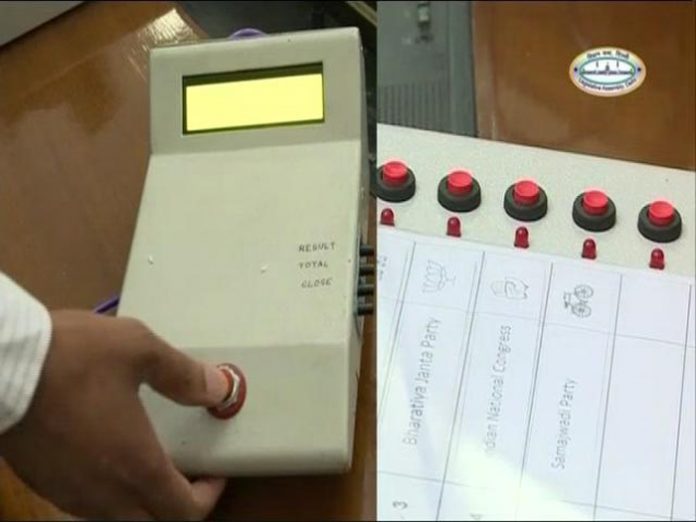By Siddhant Mohan, TwoCircles.net
CASE ONE
During the Lok Sabha elections of 2014, a post surfaced on Facebook which showed the first event in ‘Modi’ era that initiated the debate over the authenticity of Electronic Voting Machines (EVMs).
A young engineering student from Varanasi, Ankit Gaurav Srivastava uploaded a picture over Facebook where he had three EVMs opened before him. Picture was captioned as ‘Abki Baar, Modi Sarkar’.

In the comments section of the post, Ankit declared that he had rewired all the machines so that all votes from these EVMs would go to BJP candidate Narendra Modi.
The machines with which Ankit ‘posed’ and claimed them to be rewired, were held in authority by his father Awadhesh Kumar Srivastava, who was working as the divisional audit officer. He had been appointed as the sector magistrate during the General elections.
Srivastava was given three EVMs to keep in reserve and replace in case of any technical difficulty or malfunctioning during the elections.
Instead of keeping the EVMs safe, he gave those reserve EVMs to his son who then rewired the machines, leading to a huge fuss over social media.
Soon after, the Aam Aadmi Party took notice of the case and made a complaint to election commission, following which the ECI ordered the district administration to file a case against the father and the son.
However, it was not made clear until the end if those EVMs, which the young engineer tampered allegedly, were tampered at all or not because they were not used in the election process that year.
CASE TWO
Three years later, an alumnus of IIT and now a MLA from Aam Aadmi Party Saurabh Bhardwaj demonstrated in Delhi assembly that EVMs can be tampered.
Using his own replica of EVM, Bhardwaj presented a model of tampering which could only be applied in the Polling booth during the actual poll.

Bhardwaj demonstrated that anyone could enter the polling both during polls and just enter some number through the tampered motherboard of the EVM to ensure that all votes go to that specific party. He specifically chose the BJP as ones who could tamper the EVMs to get desired results.
Couple of hours after the demonstration, the ECI released a statement debunking, yet again, any possibility of EVM tampering. ECI also said that the ‘duplicate’ EVM used by AAP MLA was made to be tampered.
The only reason over non-tamperability of EVMs ECI gave was that EVMs are strictly and closely secured and function under an administrative protocol.
These two cases of two engineers have two things in common. First, that EVMs have always been a cause of worry for Aam Aadmi Party even then when it was in the nascent phase of its political journey; and second, the ECI has no obvious and clear definition to counter questions over the authenticity of EVMs.
The only reason provided by the ECI is that elections are run under the strict security protocols which also protect the EVMs before, during and after the electoral process.
After Bhardwaj’s demonstration, Delhi Chief Minister Arvind Kejriwal asked the Election commission to come up with a real EVM and claimed that Aam Aadmi Party can replace its motherboard in just 90 seconds and prove that EVMs are tamperable.
Raising the question over the motherboard or ‘Microcontroller’ of the EVM does seem obvious because microcontroller, which is a crucial part of EVM, gets manufactured outside India because of non-availability of resources in the country.
The recently released status report by ECI does not mentions any technical loophole which could possibly be explored in order to tamper or hack EVMs. It talks about security protocols around EVMs, its storage, the mock polling and sealing but nowhere claims to protect the EVM inside of a polling booth.
Besides talking about the manufacturing details of the EVMs, ECI’s status report also skips the mere possibility of changing the microcontroller, as it is claimed by Kejriwal.
However, the tussle between political parties and ECI over EVMs is not a new thing; it only resurfaced after BSP faced a defeat in 2017 UP elections. There are total of 33 cases which have been filed in different courts (including the Supreme and the High courts) of the country, out of which 27 have been dismissed by the judiciary.
While the election commission has not filled the ‘weak’ points of the whole EVM theory, the opposition has the edge. In order to counter the tampering allegations, ECI has only talked about the security which was present outside of the EVMs but has not discussed yet the inner side of it.


